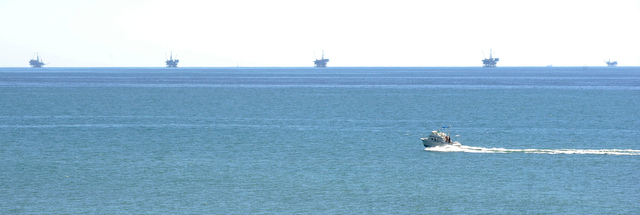Trump Proposes New Offshore Oil Development
Santa Barbara Channel in Play for First Time Since 1984

As part of a major push to achieve national “energy dominance,” President Donald Trump and Interior Secretary Ryan Zinke have unveiled new plans to open up vast swaths of the Atlantic, Pacific, and Gulf coasts — including the Santa Barbara Channel — to new oil leasing. The Santa Barbara Channel has been exempt from such efforts for the past 34 years, since Ronald Reagan was president, and the news has set off alarms among local elected officials as well as environmental activists.
“For our region, the risk is not hypothetical,” declared Congressmember Salud Carbajal. “From the oil spill of 1969 to the blowout of the Plains pipeline in 2015, we know firsthand the risks of new oil development and what happens when things go wrong.”
Kristen Hislop with the Environmental Defense Center (EDC) said the announced new lease offerings would open up 98 percent of the country’s existing offshore leases for bids by the petroleum industry. The last time any offshore lands were offered up for lease in California — and the Santa Barbara Channel — was 1984. The heads of the California Coastal Commission and State Lands Commission have both vowed to fight the new lease offering, as has Governor Jerry Brown. U.S. Senator Dianne Feinstein has denounced the announcement and State Senator Hannah-Beth Jackson issued a press release announcing the introduction of a bill to outlaw what Trump is proposing.
Leading the charge for the expansion was Interior Secretary Ryan Zinke, a frequent visitor to Santa Barbara, where his wife Lolita Zinke grew up. Carbajal complained that previous efforts to contact Zinke about issues of importance to Santa Barbarans have met with no success. “Nothing. Zero,” he exclaimed at Zinke’s lack of response. “Like the Loch Ness monster, I am told Secretary Zinke exists, but to date I have never seen him.”
The process by which the new lease offerings would take place is administratively complex and would take 18-24 months to complete. The EDC’s Kristen Hislop objected that the public would be given only 60 days to review the proposal, a shorter period than usual. She also objected the only public hearing scheduled for the proposal will take place in Sacramento, not Santa Barbara. She said she will be pushing for a Santa Barbara hearing as well as a longer comment period.
Typically, the Department of Interior prepares new leasing plans every five years. The most recent plan was adopted by the Obama administration and runs from 2017 to 2022. Under the Trump proposal, that plan would be scrapped and a new one adopted.
While Santa Barbara’s anti-oil sentiments are long established and iron clad, the oil industry has its South Coast supporters. “Becoming energy independent is in the best interest of America,” said Joe Armendariz of the Santa Barbara Technology and Industry Association, “and is one of the reasons we continue to support an ‘all of the above’ energy policy for America.” Andy Caldwell, spokesperson for the pro-oil, pro-business lobby COLAB (Coalition of Labor, Agriculture & Business), expressed skepticism the announcement would change much. “Not sure it will be a difference maker due to regulatory obfuscation by the state and county,” he said. “Having said that, it’s a great source of local energy property tax dollars and jobs.”


